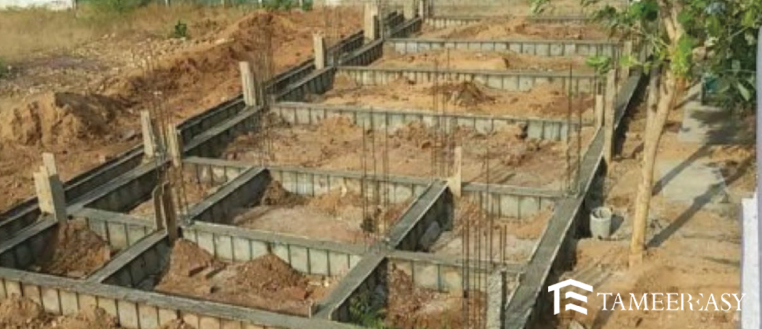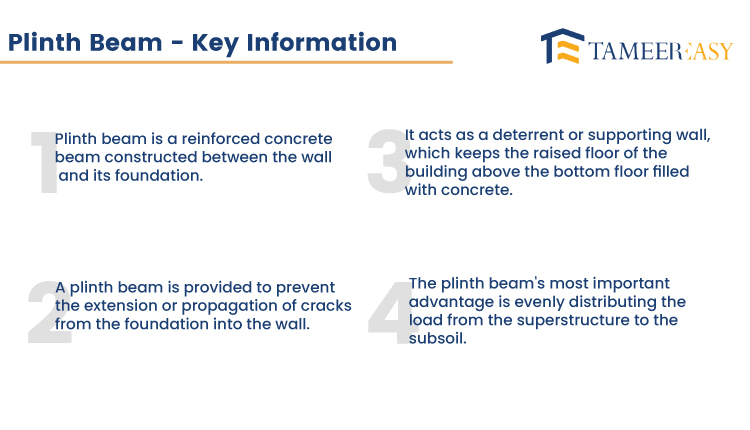The foundation’s strength is the first thing we consider when constructing a house. If the foundation is solid, the house will last very long. We employ Plinth Beam to create a solid base. Plinth Beam – what is it? What are its advantages and disadvantages? What is the ideal technique for construction? We will address these and other inquiries in this article.
Visit TameerEasy Store to Purchase Quality Construction Items

What is Plinth Beam?
The plinth beam is built into a building’s foundation and is found at the bottom level. It acts as an essential component of the structure. It is a reinforced concrete beam constructed between the foundations and the walls. The plinth beam increases the foundation’s sturdiness and strength.
How to Construct Plinth Beams?
Here are some crucial measures for constructing Plinth Beams:
Planning and Design
Consult a trained structural engineer before building the plinth beam to evaluate the site’s characteristics and measurements for proper design and planning. The engineer’s calculations establish the beam’s size, form, and reinforcement needs.
Excavation and Levelling
These are the next two steps. First, excavate to make room for the plinth beam within the building’s foundation. After levelling the ground, gravel or plain cement concrete forms a basis to support the plinth beam’s construction.
Preparing Formwork
The setting up of the formwork is the third critical phase. The plinth beam is constructed using formwork. It is a movable structure that aids in shaping the beam and stabilising the concrete. The formwork is of sturdy materials like plywood and scaffolding.
Reinforcement Placement
Then comes the step of installing Rebars inside the plinth beam as the next step in strengthening. High-strength steel rods, known as rebars, are used in concrete to increase its tensile strength and durability. Following the structural engineer’s design, rebars must be installed with the proper spacing and arrangement.
Concrete Pouring
Pouring concrete comes next. The formwork is prepared, and the plinth beams concrete mixture are poured into it. Applying the concrete evenly and utilising vibrating machinery to eliminate air bubbles is crucial. After pouring, place a cover over the beam to facilitate proper curing and strength growth.
Finishing
The plinth beam is constructed in stages, with finishing being the last. To finish, the exposed surface of smooth the beam and remove the formwork.


Benefits of Using Plinth Beam
Building a plinth beam has several advantages, including:
Strengthened Foundation
The plinth beam strengthens and stabilises the foundation of the building. It lessens the chance that the soil beneath it may settle.
Improved Load Distribution
Another advantage is the plinth beam’s crucial role in spreading loads throughout the building structure. It aids in the even distribution of loads placed on the building’s upper floors, preserving structural integrity.
Resistance to Soil Settlement
The plinth beam absorbs soil movements and prevents soil settlement, maintaining the structure of the building.
Earthquake Resistance
By protecting the structure from intense seismic shocks, the plinth beam also aids in earthquake resistance. It shields the structure from potential harm by absorbing horizontal stresses and maintaining stability.
In addition to these advantages, the plinth beam contributes to the building’s overall stability and toughness, offering protection and structural integrity over the long term.
Drawbacks of Using Plinth Beam
The first drawback is that adding a plinth beam raises the construction price. This is because its design, reinforcing, and concrete work need more labour and resources.
The second drawback is that it requires more time to finish. The time required for the discussed plinth beam building stages increases the project’s overall duration.
Why Plinth Beam is Necessary during Construction
Because it improves the strength and stability of the building foundation, creating a plinth beam is essential. This beam shields the structure from seismic stresses, soil movement, and settling. The plinth beam should be as per the applicable building codes to guarantee the building’s structural integrity and safety.
Therefore, employing a plinth beam while building homes and other structures is imperative. Always keep in mind that any construction work should be done under the guidance of a certified professional and in compliance with regional building laws and regulations.
Final Thoughts
Dear readers, maybe you better understand what a plinth beam is, how it is made, why it is made, and its advantages and disadvantages. Please feel free to contact us through our website, tameereasy, if you still need additional clarification.







